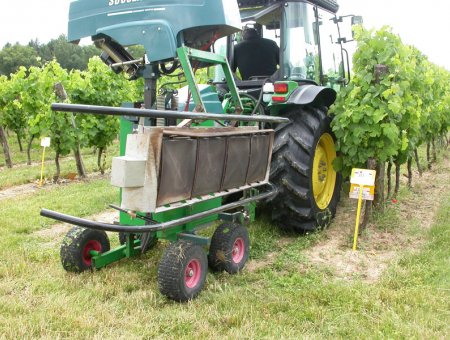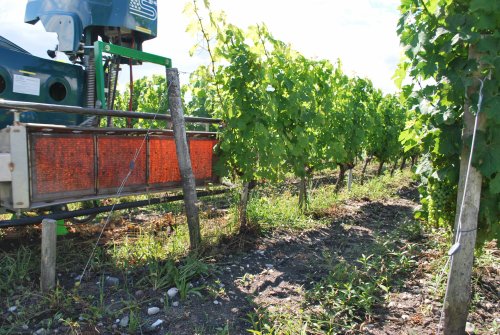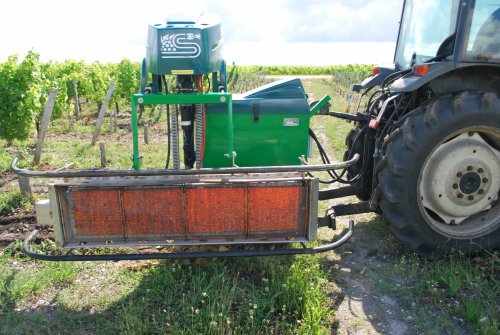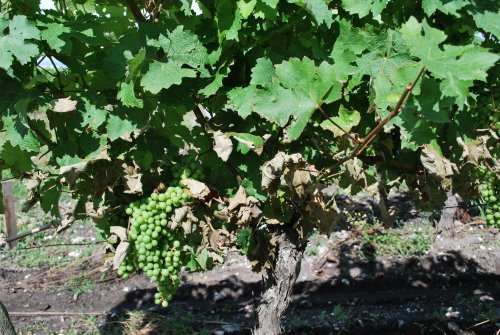Thermal leaf remover
Thermal leaf removers in viticulture use hot air to remove the leaves, causing rapid drying by thermal shock. Thanks to an incandescent radiant, they guarantee effective leaf destruction without damaging the grapes. Leaf fall occurs two to three weeks after treatment, so proper planning is essential. These devices offer a safe and precise alternative for vineyard maintenance.

Power supply
The thermal leaf remover is powered by an internal combustion engine, generally fuelled by petrol or diesel. Heated by gas, an incandescent radiant that brushes against the foliage causes rapid wilting and drying of the foliage by thermal shock , followed by leaf fall two to three weeks later. This engine drives a hot air generator which produces a flow of high-temperature air. The hot air is then directed at the leaves to be removed. The heat engine means that the machine can be used independently, without relying on an external power source.Attachment
The thermal leaf remover is generally attached to the front or rear of a tractor, depending on the model of equipment and the operator's preference. The attachment system is robust and secure, providing a stable connection between the leaf remover and the tractor. Some models can also be mounted on self-propelled carriers for greater flexibility and mobility in the vineyard.
Thermal leaf remover - Souslikoff

Thermal leaf remover - Souslikoff
Setting
The settings of the thermal leaf remover are crucial to ensure optimum efficiency and avoid damaging the vines:Air temperature
Raising the temperature to around 70°C destroys the leaves by thermal shock, shattering the cells and causing rapid drying. The temperature can be adjusted according to the thickness and density of the foliage.Air flow
The hot air flow rate is adjustable to ensure uniform, effective coverage. A higher flow rate is used for areas of dense foliage, while a lower flow rate is suitable for less dense areas.Nozzle tilt
The nozzles delivering the hot air can be tilted to direct the air flow precisely at the leaves to be removed. The angle of inclination can be adjusted to target specific areas of foliage effectively.Distance from Vines
The distance between the nozzles and the foliage can be adjusted to avoid any risk of burning the grapes. The leaf-stripping head is topped by a sensor whose distance from the radiant is adjustable, guaranteeing maximum safety.Control
Driving a thermal leaf remover requires a certain amount of skill and attention on the part of the operator. Here are the typical operating steps:Installation and preparation
The operator attaches the leaf remover to the tractor or self-propelled carrier and makes the initial settings for temperature, air flow and nozzle inclination. The heat engine is checked to ensure that it is operating correctly.Positioning
The tractor or forwarder is positioned to align the leaf remover with the rows of vines. The operator must ensure that the equipment is well centred to avoid any direct contact with the bunches.Operation
Once in place, the operator starts the engine and adjusts the tractor speed to ensure uniform coverage. Settings can be adjusted en route to take account of variations in foliage density.Safety
The operator must constantly monitor the equipment for any signs of malfunction. It is important to ensure that the nozzles are not too close to the bunches to avoid any risk of burns.Advantages and precautions
Thermal leaf removers are highly valued for their efficiency and ability to remove leaves without mechanical contact, thereby reducing the risk of injury to bunches. They are particularly useful during periods when the leaves are thick and difficult to remove by other means. By using hot air, they ensure rapid and uniform leaf removal, improving the quality of the harvest.
However, as leaf fall is not instantaneous, this technique requires some forethought depending on the desired technical itinerary. It is crucial to plan the use of the thermal leaf remover, taking into account the two to three weeks before complete leaf fall.
To sum up, a thermal leaf remover is an essential viticultural tool, combining power, precision and safety thanks to a well-designed and easily adjustable hot air production system.
However, as leaf fall is not instantaneous, this technique requires some forethought depending on the desired technical itinerary. It is crucial to plan the use of the thermal leaf remover, taking into account the two to three weeks before complete leaf fall.
To sum up, a thermal leaf remover is an essential viticultural tool, combining power, precision and safety thanks to a well-designed and easily adjustable hot air production system.

Vine after thermal leaf remover treatment
